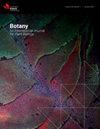First evidence of nitrogen fixation associated with bryophytes from coastal Wabanaki–Acadian forests
IF 1.3
4区 生物学
Q3 PLANT SCIENCES
引用次数: 0
Abstract
Botany, Ahead of Print.Associations between bryophytes and dinitrogen (N2)-fixing bacteria are a significant source of exogenous N in unmanaged boreal and possibly temperate ecosystems. However, the extent to which biological N2-fixation (BNF) applies to the boreal–temperate ecotone remains elusive. The current focus on common species limits our understanding of BNF at the community level. Our objective was to characterize the presence of cyanobacteria and BNF activity associated with bryophytes in the coastal forests of Fundy National Park (New Brunswick, Canada). In 2021, we harvested three liverwort and 11 moss species from two sites (71 samples) and measured environmental covariates (e.g., canopy composition and soil pH). We used stable isotope incubations with 15N2 gas in growth chambers to quantify potential BNF activity and used phycocyanin extractions as a cyanobacteria abundance proxy. Many species presented detectable BNF rates, which were similar to or higher than those of well-studied feather mosses. These included species that have rarely been found to contribute to BNF. While cyanobacteria were present on most samples, we found no positive association between abundance and BNF. Our findings are among the first records for bryophyte-associated BNF in the boreal–temperate ecotone of eastern Canada and offer insights into the potential role of this process in N cycling in coastal conifer-dominated forests.
与瓦巴纳基-阿卡迪亚沿海森林中的苔藓植物有关的固氮作用的首个证据
植物学》,提前出版。 在未加管理的北方和可能的温带生态系统中,红叶植物与二氮(N2)固定细菌之间的联系是外源氮的重要来源。然而,生物固定氮(BNF)在北方-温带生态区中的应用程度仍然难以确定。目前对常见物种的关注限制了我们对群落层面生物氮固定的了解。我们的目标是描述芬迪国家公园(加拿大新不伦瑞克省)沿海森林中蓝藻的存在以及与红叶植物相关的 BNF 活动。2021 年,我们从两个地点采集了 3 种肝草和 11 种苔藓(71 个样本),并测量了环境协变量(如树冠组成和土壤 pH 值)。我们在生长室中使用 15N2 气体进行稳定同位素培养,以量化潜在的 BNF 活性,并使用藻蓝蛋白提取物作为蓝藻丰度的替代物。许多物种出现了可检测到的 BNF 率,与研究充分的羽毛苔藓的 BNF 率相似或更高。其中包括很少被发现对 BNF 有贡献的物种。虽然大多数样本中都存在蓝藻,但我们并没有发现蓝藻丰度与 BNF 之间存在正相关。我们的研究结果是加拿大东部北方-温带生态区域首次发现与叶绿体相关的 BNF,并为了解这一过程在沿海针叶林为主的森林氮循环中的潜在作用提供了启示。
本文章由计算机程序翻译,如有差异,请以英文原文为准。
求助全文
约1分钟内获得全文
求助全文
来源期刊

Botany
生物-植物科学
CiteScore
2.20
自引率
9.10%
发文量
48
期刊介绍:
Botany features comprehensive research articles and notes in all segments of plant sciences, including cell and molecular biology, ecology, mycology and plant-microbe interactions, phycology, physiology and biochemistry, structure and development, genetics, systematics, and phytogeography. It also publishes methods, commentary, and review articles on topics of current interest, contributed by internationally recognized scientists.
 求助内容:
求助内容: 应助结果提醒方式:
应助结果提醒方式:


